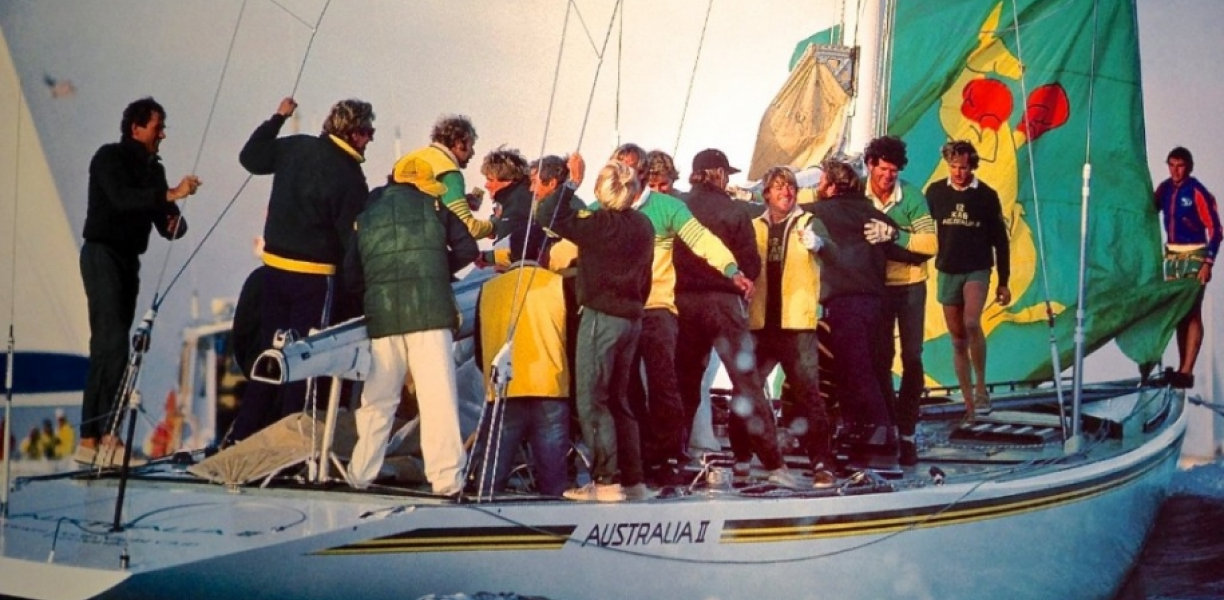Author – Ryan Miller
An award-winning journalist, content creator and photographer, Ryan is OMP’s Head of Content.
40-years ago in Newport Rhode Island a group of Australian sailors broke the world’s longest winning streak of any sport.
The plucky crew of Australia II came from 3-1 down in a first to four race series, breaking the United States’ 132-year grip on the America’s Cup.
Australia II’s win in 1983 was a watershed moment for the sport of sailing, with the challenger’s victory previously seen as an impossible feat, especially since 24 previous challengers had tried unsuccessfully to beat the Americans.
The use of a revolutionary winged keel on the Australia II is well known, but the Australians were also ahead of the curve when it came to the use of mental skills training during preparation for the America’s Cup.
The crew, led by captain John Bertrand, included a Sport Psychologist and used Visualization extensively to prepare them for the ‘Race of the Century’.
Why Mental Skills Training?
An experienced sailor, Bertrand won a Bronze Medal at the 1976 Montreal games in the Finn Class, while still an achievement to be proud of, Bertrand felt he should have performed better.
“I realised that I could have won Olympic Gold just as easily as the bronze if I had of been mentally tougher,” he told The Little Fish podcast in 2022.
In preparation for the 1983 tilt at the America’s Cup Bertrand sought out Laurie Hayden – then a consulting psychologist at the Carlton Football Club, an Australian Rules team based in Melbourne.
The addition of a sport psychologist to a team or organization may not raise eyebrows now but in 1983 it was questioned by the boat’s owner Alan Bond and the some of the Australia II’s management.

In his biography Born to Win Betrand explained that Syndicate Manager Warren Jones said to him: “Who needs a sports psychologist? We know all that needs to be known. I’ve played plenty of sport. Sure, we need a physical-fitness person for the crew but why should we have anyone screwing around with our minds? We are all tough enough ourselves. We can handle it.”
Regardless of the scepticism of Bony and Jones, Bertrand pushed on to ensure Hayden would be part of the team.
Identifying Key Areas to Improve
Together Bertrand and Hayden identified two areas of mental performance that the crew would need to work on if they were to beat the Americans led by Dennis Conner.
The first was “motivation without a tangible opponent”, essentially that during their training off the coast of Fremantle, Western Australia familiarising themselves with the yacht, they would not have an opponent, at least not one at the standard of the Americans.
The second was “Stress Control”, primarily during the America’s Cup races and potentially a seventh and final race, the Australian crew would be subjected to stress unlike any they’d faced before.
Part of “Stress Control” dealt with the Australians not knowing what it was like to lead a race, let alone win one. Before the 1983 America’s Cup, Australia’s six challengers had won just three of 22 races.
Bertrand, who had been a member of the 1970, 1974 and 1980 challenges identified that while he knew what it was like to be behind the American boat, he didn’t know what it was like to lead.
Visualization
Visualization would play a major part in the Australian’s preparation for the America’s Cup in Newport.
With Bertrand – the most experienced crew member – having little experience leading in an America’s Cup race, he knew that the race would feel and sound different if or when they took the lead.
In his biography, Bertrand describes that he knew what the race would sound and look like when chasing the American boat, Liberty. They were used to the voices of the American crew when they were losing a race so what would it be like when they were leading? What would those Americans say? This would add a new element of pressure.
The only way the Australian crew could become comfortable in a situation like this was to visualize it in their mind’s eye. As Bertrand put it in his biography – “Remember you cannot go anywhere if you have not first imagined yourself there. People achieve that which they have imagined themselves achieving over and over in their minds.”
Bertrand personally used visualization every night before bed, locking himself away for at least 15 minutes to see himself skippering his crew into the lead. The crew would also gather for group visualization sessions to imagine themselves and how they would win the America’s Cup.
Motivation & Confidence
The Australians were all too aware of the United States’ dominance of the America’s Cup and made sure that it did not play on their minds.
“The antidote to history is logic,” Bertrand said in his biography. “Past has no bearing on the now.”

Part of making sure that his crew never slipped into being daunted by the prospect of creating history, Betrand had them complete an Attentional and Interpersonal Style Test with Hayden interpreting their responses to give Betrand a better understanding his crew mates’ personalities, reaction to multiple directives, reaction to stress, intrinsic motivations and how best to communicate with them.
This test led Betrand to understand that they responded better to complimentary communication from him and that his own test showed that he had lapses in concentration during the middle part of a race when fatigue and a tendency to linger on the negative thoughts associated with mistakes set in.
To help boost their confidence and motivate themselves, the crew adopted the Boxing Kangaroo flag as their insignia and would play “Land Down Under” by Men at Work when leaving port as a battle song. They also used the song to intimidate the American crew, blasting it towards the Liberty ahead of each race.
Fear of the Unknown
One of the psychological masterstrokes was hiding Australia II’s winged keel. When the boat was out of the water following the qualifying races and then the America’s Cup itself, the Australians kept the keel hidden under a sheet of fabric with around the clock security.
The intention was to instil the Americans with the fear of the unknown. As the Australians dominated their opponents in the qualifying races, the mystery of what was below the water played on the minds of the American crew and distracted the club they were representing.
As the races continued the Americans would never truly know what they were up against.
Performing Under Pressure
The Australians started both the first and second races strongly but lost both after experiencing equipment failure.
Australia II won the third race by a record margin, but then lost the fourth race and were on the praecipes of losing another challenge.
With the series standing at 3-1 the Australians were feeling the weight of pressure knowing that one mistake in the fifth race could be the end of their dream and were frustrated with their performance as they knew they were better than what the ledger showed.
To mitigate the pressure the crew was feeling, they shut out all external noise, removing all the televisions in the crew’s quarters, not allowing newspapers in and stopped all phone calls and focussed on controlling what they could control.
“Not being restricted by the consequences of losing,” Betrand said. “It’s like cancer. When you move into the world of winning and losing and the consequences of either being a national hero or being a bum.”
“We were in the business of trying to let it flow, maximizing the potential of what we had.
“If we did our job – we’re not talking about superhuman stuff – from the bow to the stern if everyone can complete their job as good as or better than the person in the opposition boat, we’ve got a good chance of being invited back tomorrow. (It was) A very simple philosophy.”
Race Seven
The ploy to shut out all external noise and “release the beast” worked.
Australia II would beat the liberty in the next two races, both by large margins. The wins meant that the 1983 America’s Cup would all come down to a fifth and final race.
The Americans, desperate be competitive in the final race made drastic changes to their boat. The changes worked and they would lead the final race by 57 seconds. Back home in Australia millions watched their TV sets thinking the race was lost.
Despite being so far behind the Americans, the Australian crew stuck to their process and waited for the Americans to make a mistake.
“Don’t give up, don’t panic and don’t do anything rash – just keep on sailing the boat,” Betrand said.
Eventually the American crew did make a mistake and with the Australians following a channel of wind they not only gained on the U.S but overtook them.
As they had visualized, they were in front of the Americans in the final race. Their mental preparation made them ready for the challenge, instead of caving into the pressure being on the cusp of a historic victory, each of the Australians continued to execute their role with excellence.
They continued to put distance between themselves and the American boat. When they crossed the finish line, they were 41 seconds ahead of the Americans and had sailed into the history books.
Victory
Australia II’s victory in race seven the 1983 America’s Cup was the culmination of the Australian crews’ physical and mental preparation.
The Liberty crew were spooked by the mystery that shrouded the winged keel, the Australians never wavered in their self-belief and maintained their composure under immense pressure, and most importantly when they were in the lead, they continued to control the controllables as they had been there before thanks to the use of visualization.
The achievement of Bertrand and his crew still stands as one of Australia’s greatest team or individual sporting triumphs.
References
Born to Win – John Betrand as told to Patrick Robinson (Bantam Books, 1985)
Untold: The Race of the Century (Netflix, 2022)





